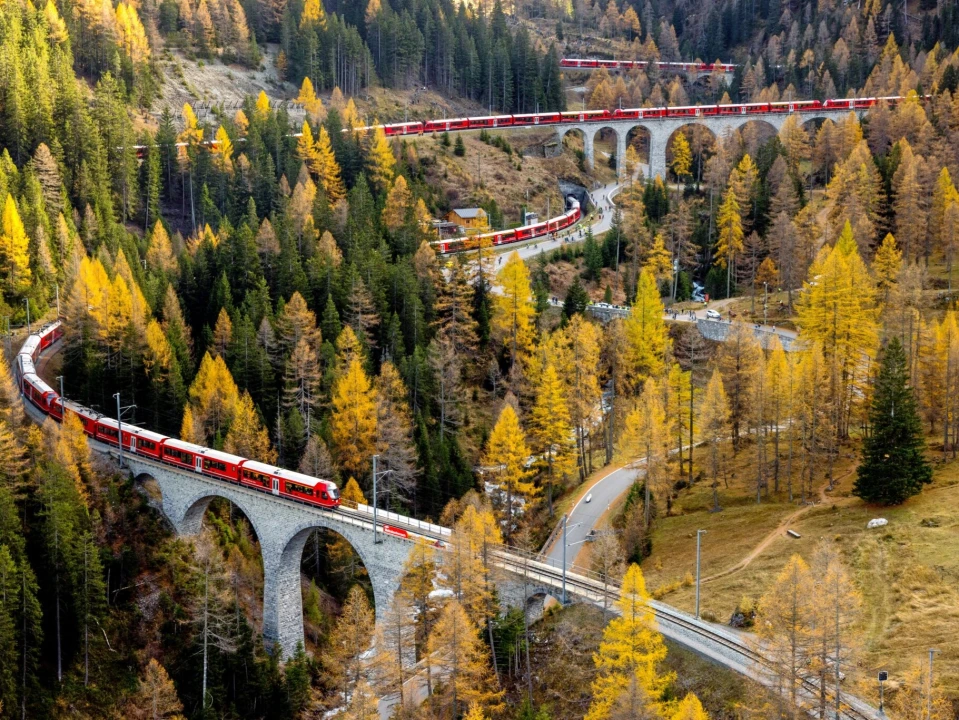The Rhaetian Railway is a mountain railroad network whose lines connect Italy to Switzerland, via a long labyrinth of wide valleys and mountain passes. Added to the UNESCO World Heritage List in 2008, the part of the Rhaetian Railway running through Albula and Bernina is not like any other: its tracks, completed at the beginning of the 1900s, had an enormous socio-economic impact on the mountain community, helping to – finally – free it from its long isolation.
And with its two narrow-gauge lines, the railway infrastructure constitutes an engineering, architectonic and administrative feat without comparison, ideal for traversing the impervious mountain terrain. One of the most spectacular in the world, the Rhaetian Railway’s itinerary offers its passengers breathtaking views and intense emotions.
Initially, only the rail line between Thusis and Campocologno (in Switzerland) was proposed for UNESCO candidacy; however, such led to the tutelage and protection of the Albula line running from Thusis to Tirano (in Lombardy, Province of Sondrio), which also comprises the Bernina Line (from St. Moritz to Tirano).
The two lines, eventually reunited by the Rhaetian Railway Company, have remained almost entirely intact all this time. All together, the lines cross through 55 tunnels and over 196 viaducts, at heights above 6,562 feet. The first to be completed was the Albula Railroad, opened in 1904 with a route complex of 42 mi, 42 tunnels and 144 viaducts. Built in the local stone, the Albula Railway was a classic mountain railroad for steam trains that were later converted to electricity in 1919.
Originally the property of another company, the Bernina Railroad, rather, was constructed around 1910, to cover 38 miles, 13 tunnels, and 52 viaducts. It is one of the highest-altitude Transalpine tracks in Europe, and one of the naturally-steepest in the world, traveling at a seven-percent incline in parts without the use of rack and pinion.
Still active in the present day, the Rhaetian Railway - along which the Little Red Train of Bernina still chugs - is a touristic destination in its own right, an exciting experience of moving landscapes, deep, wide valleys, and snow-covered mountaintops that would be impossible to see any other way! The lines open Italy to the Valley of Engadina and the Swiss Canton of Graubunden, enhancing international tourism and, in time, making itself an excellent catalyst for the development of winter sports activity.
In the environs
For those that love not only relaxing mountain sceneries, but also history and even archaeology, take the opportunity to see the archaeological parks of the rupestrian art of Valcamonica. Sonico, one of the beautiful sites containing the prehistoric finds, is less than an hour away from Tirano, the Rhaetian Railway’s end of the line.
The true attraction of the zone is, above all, the number of well-outfitted ski resorts in Valtellina, just a half-hour’s distance away. Valtellina boasts internationally-famous ski hubs, including Livigno, Bormio, Santa Caterina Valfurva, Madesimo, Chiesa Valmalenco, Aprica and Valgerola. The slopes expand over 249 miles, inviting tourists to enjoy a vacation of winter sports and relaxation amidst gorgeous natural surroundings – an experience only enriched by the excellent local delicacies (cheeses, desserts, etc.) and celebrated D.O.C. wines.




